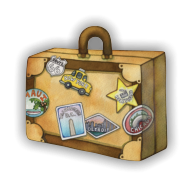Teacher’s Guide
Map Skill Work
![]()
Students can practice map skills by identifying the top ten cities Benson travels to throughout the book.
Begin by locating a map of the state of Michigan. (You can request a free map of the state of Michigan by visiting the Michigan Department of Transportation website.)
As you read about each location, mark the city on the map. Have students identify how they would travel from their home to the city by using directional terms (north, south, east, and west). Students can also locate the cities where Benson’s friends and families live. Ask students to identify where the top ten cities are in relation to home of friends and family members (ie: Midland is north of Ann Arbor).
BONUS: Students in need of more advanced map work can identify the route to the top ten cities from their home using the state’s major highways or interstates.
Writing
![]()
Teachers can use Benson’s Adventures in Michigan to focus on the components of writing, specifically the components of a postcard. Teachers can download and print many free templates online for students to practice writing and addressing postcards. You can even extend this writing into friendly letters and addressing envelopes.
Additional idea: Students love to receive mail, so teachers could create a post office in their classroom for students to write and receive postcards or letters from their classmates.
Donations: Ask your friends, your family members, and students’ parents to donate old cards, stationary, or postcards for your students to use in your writing center.
Field Trip Idea: Take a field trip to the post office! Postmasters are always so helpful in explaining the tools, resources, and many jobs associated with the United States Postal Service.
Learning Opportunity
![]()
Additional Learning Opportunities
Write Benson: Benson would love to hear from you and your students! Please send mail to: Benson, 10871 S. Durand Rd., Durand, MI 48429.
Recipes: Complete one of the recipes located inside our book. Post a class picture on our Facebook page or email the picture to:
Info@BensonsAdventures.com. If you and your students have a favorite fall recipe or chocolate recipe to share with Benson, please send it as well!
MAP: Share the Michigan Activity Pass (MAP) with your families. Families can rent a pass to museums, parks, etc. free of charge. To learn more, visit
www.PlymouthRockets.com
Telling Time– Teach your students about time. Work on telling time on the different types of clocks found throughout your school. You can create your own clocks to practice telling time.

Authors
Tracy Foster:
(810) 845-4983
Shannon Cooper-Toma:
(989) 233-2745
E-mail: Info@BensonsAdventures.com
Science
![]()
Identify – Download a chart of butterflies and insects native to Michigan. Go outside and see how many butterflies you and your students can find and identify. Visit a local butterfly house to identify different types of butterflies.
Observe– During travels to the Great Lakes, look for Petoskey stones and share the science behind these beautiful prehistoric fossils that once lived over 350 million years ago. At school, ask students to collect rocks found at home. Using a magnifying glass to observe their features, try to identify the type of each rock.
Measure – Traverse City and Mackinac City offer science sails to explore different topics in science. Students can measure the clarity of water, look at plankton, and chart wind speed and air temperature. Visit a local pond or lake to collect and look at plankton under a microscope. Ask students to read a thermometer to record the temperature each day and discuss the daily changes in temperature. Students can also create a wind sock to learn about wind direction.
Teacher’s Guide
![]()
Friends,
We believe children should be curious, inspired, and encouraged to DREAM BIG. As educators, we know books and travel can take children to magical places beyond their homes, classrooms, and communities. As you share Benson’s Adventures in Michigan, we hope your students understand that a world of Michigan travel adventures and opportunities awaits them and that they can make a difference by following their dreams.
We created this Teacher’s Guide to provide educators with ideas on how to use this book as a teaching tool before students take the book home to enjoy with their family. As you use this resource and identify even more ways to use this book, please share your ideas with us Info@BensonsAdventures.com
Happy reading,
Tracy and Shannon
Native American Culture
![]()
Legends and stories help make a culture. The Ojibwa people share stories that give life to the moon and stars. The Ojibwa were the first people to travel and live at the lakeshore and surrounding area. Their legends date back thousands of years. Read the following stories. If possible, share the stories under the night sky.
Moon—The man in the moon is a Nishnaabe man (Original Man). He is bending forward with his head somewhat down praying for “Mother Earth”. If you look close when he is in full moon, you will see feathers on his head.
Northern Lights—(Wassnodae)—Ojibwa ancestors are dancing and meeting those people that have passed on, leading them to the Milky Way, which is called the Jiibay Mikana (Ghost Road).
Bigfoot (Chi Sawbe) —The Big Dipper including the belt is called the Nanabush Anung. The Ojibwa feel that Nanabush is the older brother and teacher to their people. Nanabush Anung will at times take the form of a furry giant, and is also called a trickster. Some of the elders will joke
that this could give him the name Bigfoot (Chi Sawbe) constellation

